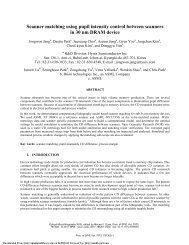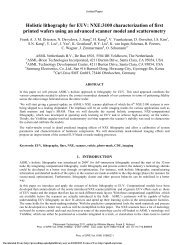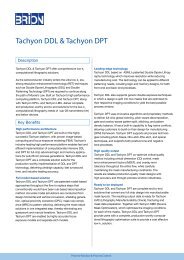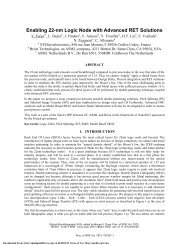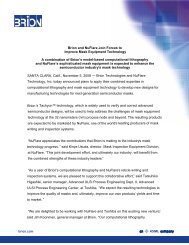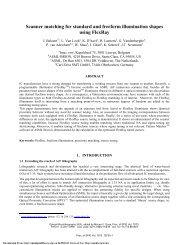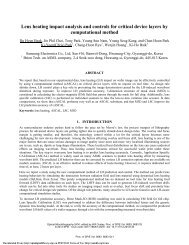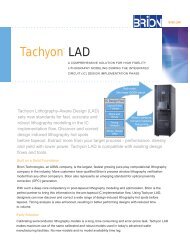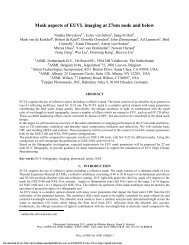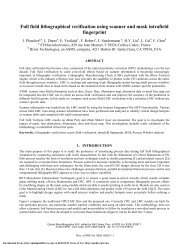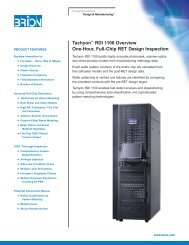Fast 3D thick mask model for full-chip EUVL simulations
Fast 3D thick mask model for full-chip EUVL simulations - Brion ...
Fast 3D thick mask model for full-chip EUVL simulations - Brion ...
- No tags were found...
You also want an ePaper? Increase the reach of your titles
YUMPU automatically turns print PDFs into web optimized ePapers that Google loves.
In the following sections, we first discuss some special considerations in <strong>EUVL</strong> <strong>simulations</strong> with rigorous <strong>3D</strong> <strong>mask</strong><br />
<strong>model</strong>s. These considerations are required in order to obtain realistic simulation results. Then we describe the<br />
development of the fast <strong>3D</strong> <strong>mask</strong> <strong>model</strong> <strong>for</strong> <strong>full</strong>-<strong>chip</strong> EUV applications, followed by simulation case studies to validate<br />
its accuracy against a rigorous <strong>3D</strong> <strong>mask</strong> <strong>model</strong>. A summary of this work is given in the end.<br />
2. <strong>EUVL</strong> SIMULATION CONSIDERATIONS<br />
Due to limited availability of experimental data <strong>for</strong> future device dimensions, the rigorous simulation remains the main<br />
vehicle to study the various effects in EUV lithography. In this work rigorous <strong>simulations</strong> will be used to generate<br />
reference data to evaluate the accuracy of the fast <strong>3D</strong> <strong>mask</strong> <strong>model</strong>. There<strong>for</strong>e it is important to carry out the rigorous<br />
<strong>simulations</strong> properly to ensure valid results are obtained.<br />
2.1 Mask defocus effect<br />
As EUV lithography uses a reflective <strong>mask</strong> illuminated with an oblique chief ray angle, the condition of telecentricity is<br />
no longer satisfied on the <strong>mask</strong> side as compared to DUV lithography. Consequently the effects of <strong>mask</strong> defocus are<br />
much more significant in EUV lithography. This aspect is particularly evident in lithography <strong>simulations</strong> using rigorous<br />
<strong>3D</strong> <strong>mask</strong> <strong>model</strong>s. In these <strong>simulations</strong> the transmitted (DUV) or reflected (EUV) <strong>mask</strong> fields are generally sampled at a<br />
pre-determined plane close to the top surface of the <strong>mask</strong> features. If these <strong>mask</strong> fields are directly used <strong>for</strong> subsequent<br />
image <strong>simulations</strong>, which implies that the sample plane is chosen as the object plane of the project lens, the images<br />
obtained at its conjugate image plane may not be optimum in terms of image contrast and pattern shift. As shown in<br />
Figure 1, the distance between the object plane and the sample plane is referred to as the <strong>mask</strong> defocus in this work.<br />
Multi -layer<br />
ens object plane<br />
sorber<br />
Mask defocus<br />
field sample plane<br />
Figure 1: Definition of <strong>mask</strong> defocus <strong>for</strong> this work<br />
From <strong>model</strong>ing point of view, the <strong>mask</strong> defocus effect may be ignored in DUV <strong>simulations</strong>, but it cannot be ignored in<br />
EUV <strong>simulations</strong>, especially <strong>for</strong> pattern shift. Note the effect of <strong>mask</strong> defocus is similar to wafer defocus but on a much<br />
smaller scale. It can be shown that the image change due to a <strong>mask</strong> defocus of m is approximately equivalent to a wafer<br />
defocus of w =M 2 m <strong>for</strong> low NA imaging, where M is the magnification of the projection lens. For a 4x reduction<br />
system, M 2 =1/16. For CD control this effect may be ignored or largely compensated by a small change in wafer defocus.<br />
But <strong>for</strong> pattern shift, it is a quite different situation between DUV and EUV.<br />
Many factors can contribute to the image shift of a pattern with respect to its position on the <strong>mask</strong>, including pattern<br />
symmetry, source symmetry, lens aberration, phase error induced by <strong>3D</strong> <strong>mask</strong> topography, <strong>mask</strong> defocus, wafer defocus,<br />
etc... We will only consider an aberration-free system in this work. For a symmetric pattern, it can be easily shown that<br />
the pattern shift caused by the defocus and/or <strong>3D</strong> <strong>mask</strong> topography can be cancelled out exactly by using a symmetric<br />
illumination pupil shape. This condition is generally satisfied in practical DUV applications. There<strong>for</strong>e the <strong>mask</strong> defocus<br />
effect rarely needs to be <strong>model</strong>ed in DUV <strong>simulations</strong>. However, due to the reflective <strong>mask</strong> and the oblique chief ray<br />
angle employed by EUV lithography, it is impossible to make a symmetric illumination pupil shape from the <strong>mask</strong><br />
viewpoint. As a result the pattern shift in EUV is not as trivial as in DUV. The contribution from the <strong>mask</strong> defocus is<br />
significant and generally global across all patterns. In addition, a <strong>mask</strong> pattern sees a slightly different illumination pupil<br />
Proc. of SPIE Vol. 8679 86790W-2<br />
Downloaded From: http://spiedigitallibrary.org/ on 05/06/2013 Terms of Use: http://spiedl.org/terms



